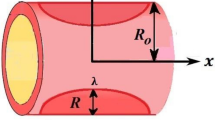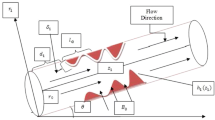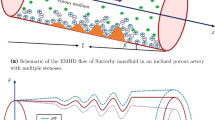Abstract
Literature survey related to the nanoparticles reveals that nanofluids are getting popularity in hematological treatment. Development in this direction motivated us to write a theoretical study on unsteady blood motion in stenosed vessel with nanoparticles. Geometry of a stenosed arterial section is being written mathematically by an appropriate geometric expression. The constitutive equation of Carreau fluid model is used to characterize the dynamical behavior of the blood. The rheology of the blood is formulated mathematically by coupled partial differential equations. Similarly, the effects of nanoparticles are incorporated mathematically into governing equations by using Buonjiornio’s formulation. Mild stenotic condition is employed to reduce the two-dimensional differential equations to simple form. Numerical technique is being used to obtain the numerical solution to the existing problem. The obtained simulation reveals that the magnitude of velocity shows an accelerating behavior for Brownian motion parameter and shows deceleration trend on increasing the thermophoresis parameter. Similarly, the instantaneous behavior of blood flow pattern is shown through streamlines.










Similar content being viewed by others
References
Ku DN (1997) Blood flow in arteries. Ann Rev Fluid Mech 29:399–434
Boyd J, Buick J, Cosgrove JA, Stansell P (2005) Application of the lattice Boltzmann model to simulated stenosis growth in a two-dimensional carotid artery. Phys Med Biol 50(20):4783
Yap C, Dasi LP, Yoganathan AP (2010) Dynamic hemodynamic energy loss in normal and stenosed aortic valves. ASME J Biomech Eng 132(2):021005
Karri S, Vlachos PP (2010) Time-resolved DPIV investigation of pulsatile flow in symmetric stenotic arteries effects of phase angle. ASME J Biomech Eng 132(3):031010
Pinto SIS, Costa ED, Campos JBLM, Miranda JM (2010) Study of blood flow in a bifurcation with a stenosis. In: 15th international conference experimental mechanics, Porto/Portugal, 22–27 July
Daiswamy N, Schoephoerster RT, Moreno MR, Moore JE (2007) Stented artery flow patterns and their effects on the artery wall. Ann Rev Fluid Mech 39:357–382
Sforza DM, Putman CM, Cebral JR (2009) Hemodynamics of cerebral aneurysms. Ann Rev Fluid Mech 41:91–107
Chakravarty S, Mandal PK (1994) Mathematical modelling of blood flow through an overlapping arterial stenosis. Math Comput Mod 19:59–70
Qiao A, Zhang Z (2014) Numerical simulation of vertebral artery stenosis treated with different stents. ASME J Biomech Eng 136(4):041007
Chakravarty S, Mandal PK (2000) Two-dimensional blood flow through tapered arteries under stenotic conditions. Int J Non-Linear Mech 35:779–793
Riahi DN, Roy R, Cavazos S (2011) On arterial blood flow in the presence of an overlapping stenosis. Math Comput Model 54:2999–30006
Ikbal MA, Chakravarty S, Sarifuddin, Mandal PK (2012) Unsteady analysis of viscoelastic blood flow through arterial stenosis. Chem Eng Commun 199: 40–62
Zaman Akbar, Ali Nasir, Anwar Bég O, Sajid M (2016) Unsteady two-layer blood flow through a w-shape stenosed artery using the generalized Oldroyd-B fluid model. ANZIAM J 58:96–118
Yilmaz F, Gundogdu MY (2008) A critical review on blood flow in large arteries; relevance to blood rheology, viscosity models, and physiologic conditions. Korea-Aust Rheo J 20:197–211
Shaw S, Gorla RSR, Murthy PVSN, Ng CO (2009) Pulsatile Casson fluid flow through a stenosed bifurcated artery. Int J Fluid Mech Res 36(1):43–63
Cho YI, Kensey KR (1991) Effects of non-Newtonian viscosity of blood on flows in a diseased arterial vessel. Part 1: steady flows. Biorheology 28:241–262
Zaman A, Ali N, Anwar Bég O (2015) Unsteady magnetohydrodynamic blood flow in a porous-saturated overlapping stenotic artery: numerical modeling. J Mech Med Biol 16:16. https://doi.org/10.1142/s0219519416500494
Haghighi AR, Asl MS, Kiyasatfar M (2015) Mathematical modeling of unsteady blood flow through elastic tapered artery with overlapping stenosis. J Braz Soc Mech Sci Eng 37:571–578
Branes HA, Hutton JF, Walter K (1989) An introduction to rheology. Elsevier, Amsterdam
Choi SUS (1995) Enhancing thermal conductivity of fluid with nanoparticles. In: Siginer DA, Wang HP (eds) Developments and application of non-Newtonian flows, 66. ASME, New York, pp 99–105
Yoo JW, Chambers E, Mitragotri S (2010) Factors that control the circulation time of nanoparticles in blood: challenges, solutions and future prospects. Curr Pharm Des 16(21):2298–2307
Tripathi D, Anwar Bég O (2014) A study on peristaltic flow of nanofluids: application in drug delivery systems. Int J Heat Mass Trans 70:61–70
Nadeem S, Ijaz S (2015) Theoretical analysis of metallic nanoparticles on blood flow through stenosed artery with permeable walls. Phys Lett A 379:542–554
Harris DL, Graffagnini MJ (2007) Nanomaterials in medical devices: a snapshot of markets, technologies and companies. Nanotechnol Law Bus Winter 4:415–422
Fullstone G, Wood J, Holcombe M, Battaglia G (2015) Modelling the transport of nanoparticles under blood flow using an agent-based approach. Nat Sci Rep 5(10649):1–13
Tan J, Thomas A, Liu Y (2012) Influence of red blood cells on nanoparticle targeted delivery in microcirculation. Soft Matter 8:1934–1946
Gentile F, Ferrari M, Decuzzi P (2008) The transport of nanoparticles in blood vessels: the effect of vessel permeability and blood rheology. Ann Biomed Eng 36(2):254–261
Ali N, Zaman A, Sajid M, Nietoc JJ, Torres A (2015) Unsteady non-Newtonian blood flow through a tapered overlapping stenosed catheterized vessel. Math Bio sci 269:94–103
Burton AC (1966) Physiology and biophysics of the circulation, Introductory text. Year Book Medical Publisher, Chicago
Ling SC, Atabek HB (1972) A nonlinear analysis of pulsatile flow in arteries. J Fluid Mech 55:493–511
Hoffmann KA, Chiang ST (2000) Computational Fluid Dynamics. Engineering Edition System, Wichita
Rana P, Bhargava R, Anwar Beg O (2013) Finite element simulation of unsteady MHD transport phenomena on a stretching sheet in a rotating nanofluid. Proc. IMECHE- Part N. J Nanoeng Nanosyst 227:77–99
Bhargava R, Sharma S, Anwar Bég O, Zueco J (2010) Finite element study of nonlinear two-dimensional deoxygenated biomagnetic micropolar flow. Commun Nonlinear Sci Numer Simul 15:1210–1233
Anwar Bég O, Bég Tasveer A, Bhargava R, Rawat S, Tripathi D (2012) Finite element study of pulsatile magneto-hemodynamic non-Newtonian flow and drug diffusion in a porous medium channel. J Mech Med Biol 12:1250081.1–1250081.26
Zaman Akbar, Ali Nasir, Anwar Bég O (2015) Numerical simulation of unsteady micropolar hemodynamics in a tapered catheterized artery with a combination of stenosis and aneurysm. Med Biol Eng Comput. https://doi.org/10.1007/s11517-015-1415-3
Zaman A, Ali N, Sajid M, Hayat T (2016) Numerical and analytical study of two-layered unsteady blood flow through catheterized artery. PLoS ONE 11(8):e0161377. https://doi.org/10.1371/journal.pone.0161377
Author information
Authors and Affiliations
Corresponding author
Additional information
Technical Editor: Cezar Negrao.
Rights and permissions
About this article
Cite this article
Zaman, A., Khan, A.A. & Ali, N. Modeling of unsteady non-Newtonian blood flow through a stenosed artery: with nanoparticles. J Braz. Soc. Mech. Sci. Eng. 40, 307 (2018). https://doi.org/10.1007/s40430-018-1230-5
Received:
Accepted:
Published:
DOI: https://doi.org/10.1007/s40430-018-1230-5




